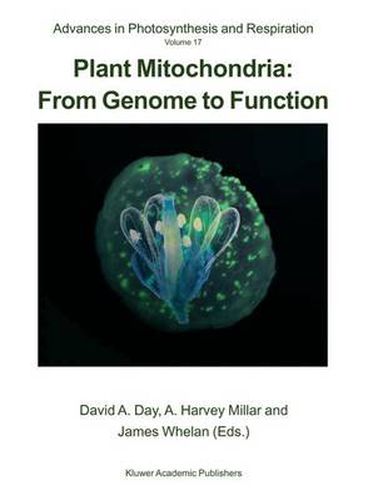Readings Newsletter
Become a Readings Member to make your shopping experience even easier.
Sign in or sign up for free!
You’re not far away from qualifying for FREE standard shipping within Australia
You’ve qualified for FREE standard shipping within Australia
The cart is loading…






This title is printed to order. This book may have been self-published. If so, we cannot guarantee the quality of the content. In the main most books will have gone through the editing process however some may not. We therefore suggest that you be aware of this before ordering this book. If in doubt check either the author or publisher’s details as we are unable to accept any returns unless they are faulty. Please contact us if you have any questions.
Mitochondria in plants, as in other eukaryotes, play an essential role in the cell as the major producers of ATP via oxidative phosphorylation. However, mitochondria also play crucial roles in many other aspects of plant development and performance, and possess an array of unique properties which allow them to interact with the specialized features of plant cell metabolism. The two main themes running through the book are the interconnection between gene regulation and protein function, and the integration of mitochondria with other components of plant cells.
The book begins with an overview of the dynamics of mitochondrial structure, morphology and inheritance. It then discusses the biogenesis of mitochondria, the regulation of gene expression, the mitochondrial genome and its interaction with the nucleus, and the targeting of proteins to the organelle. This is followed by a discussion of the contributions that mutations, involving mitochondrial proteins, have made to our understanding of the way the organelle interacts with the rest of the plant cell, and the new field of proteomics and the discovery of new functions. Also covered are the pathways of electron transport, with special attention to the non-phosphorylating bypasses, metabolite transport, and specialized mitochondrial metabolism.
In the end, the impact of oxidative stress on mitochondria and the defense mechanisms, that are employed to allow survival, are discussed. This book is for the use of advanced undergraduates, graduates, postgraduates, and beginning researchers in the areas of molecular and cellular biology, integrative biology, biochemistry, bioenergetics, proteomics and plant and agricultural sciences.
$9.00 standard shipping within Australia
FREE standard shipping within Australia for orders over $100.00
Express & International shipping calculated at checkout
This title is printed to order. This book may have been self-published. If so, we cannot guarantee the quality of the content. In the main most books will have gone through the editing process however some may not. We therefore suggest that you be aware of this before ordering this book. If in doubt check either the author or publisher’s details as we are unable to accept any returns unless they are faulty. Please contact us if you have any questions.
Mitochondria in plants, as in other eukaryotes, play an essential role in the cell as the major producers of ATP via oxidative phosphorylation. However, mitochondria also play crucial roles in many other aspects of plant development and performance, and possess an array of unique properties which allow them to interact with the specialized features of plant cell metabolism. The two main themes running through the book are the interconnection between gene regulation and protein function, and the integration of mitochondria with other components of plant cells.
The book begins with an overview of the dynamics of mitochondrial structure, morphology and inheritance. It then discusses the biogenesis of mitochondria, the regulation of gene expression, the mitochondrial genome and its interaction with the nucleus, and the targeting of proteins to the organelle. This is followed by a discussion of the contributions that mutations, involving mitochondrial proteins, have made to our understanding of the way the organelle interacts with the rest of the plant cell, and the new field of proteomics and the discovery of new functions. Also covered are the pathways of electron transport, with special attention to the non-phosphorylating bypasses, metabolite transport, and specialized mitochondrial metabolism.
In the end, the impact of oxidative stress on mitochondria and the defense mechanisms, that are employed to allow survival, are discussed. This book is for the use of advanced undergraduates, graduates, postgraduates, and beginning researchers in the areas of molecular and cellular biology, integrative biology, biochemistry, bioenergetics, proteomics and plant and agricultural sciences.